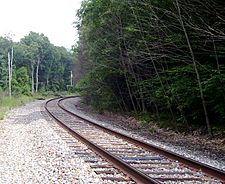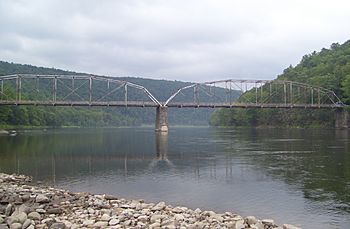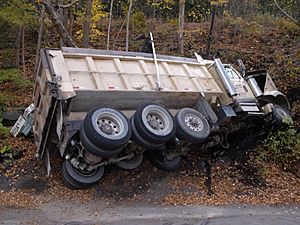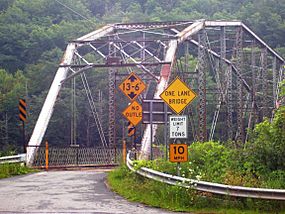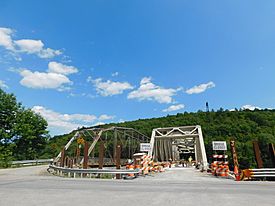Pond Eddy Bridge facts for kids
Quick facts for kids Pond Eddy Bridge |
|
|---|---|
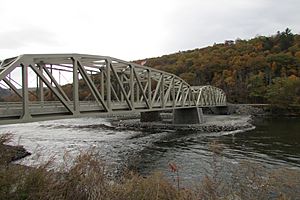 |
|
| Coordinates | 41°26′21″N 74°49′13″W / 41.43917°N 74.82028°W |
| Carries | Quadrant Route 1011 (Pennsylvania) |
| Crosses | Delaware River |
| Locale | Pond Eddy, NY-PA |
| Owner | New York–Pennsylvania Joint Interstate Bridge Commission |
| Maintained by | New York–Pennsylvania Joint Interstate Bridge Commission |
| Heritage status | NRHP #88002170 |
| ID number | 000000000029949 |
| Characteristics | |
| Design | Petit truss |
| Material | Steel, wood |
| Total length | 521 feet (159 m) |
| Width | 12 feet (3.7 m) |
| Number of spans | 2 |
| Load limit | 4 tons |
| Clearance above | 13.5 feet (4.1 m) |
| Clearance below | 31 feet (9.4 m) |
| History | |
| Designer | Oswego Bridge Company |
| Constructed by | Oswego Bridge Company |
| Opened | 1903 |
| Statistics | |
| Daily traffic | 29 |
The Pond Eddy Bridge is a special type of bridge called a petit truss bridge. It stretches across the Delaware River. This bridge connects the small community of Pond Eddy in New York with a similar area in Shohola Township, Pennsylvania.
The bridge was built in 1903. It replaced an older suspension bridge that was washed away by a big flood. This new bridge was very important. It helped transport bluestone from quarries in Pennsylvania to New York.
Over the years, the bridge started to get old and weak. It was even called "Structurally Deficient," meaning it needed serious repairs or replacement. Because of its condition, plans began in 1999 to replace it. In 2015, a dump truck accident caused even more damage. This sped up the plans to build a new bridge. The new Pond Eddy Bridge was finished in November 2018.
Contents
History of the Pond Eddy Bridge
The First Bridge: 1870
The area around Pond Eddy grew because of the Delaware and Hudson Canal and the Erie Railroad. As more people moved to both sides of the river, they needed a way to connect. A bridge would make it easier to move bluestone, slate, and lumber.
So, in 1870, a new bridge was built. It was a wire-rope suspension bridge, similar to designs by famous engineer John Augustus Roebling. James D. Decker, a local official, oversaw the building. People even called it "Decker's Bridge" because he lived so close. The bridge was about 521 feet (159 meters) long and 12 feet (3.7 meters) wide. It stood 31 feet (9.4 meters) above the water.
At first, the bridge was free for local residents. Later, it was sometimes leased to private people who collected tolls. The small building where tolls were collected was eventually removed and became a home. The Pennsylvania side of Pond Eddy was originally called Flagstone. It changed its name after the bridge was built. Both communities grew quickly. A new train station opened in Pennsylvania. The New York side had stores, a church, a telegraph office, homes, and a hotel.
However, the good times didn't last. The canal closed in 1898 because of competition from railroads. The train station in Pennsylvania didn't have good road access. The communities started to decline.
The 1903 Steel Bridge
In 1903, huge floods hit the Delaware River Valley. Two strong storms caused massive flooding on October 9. The 1870 suspension bridge was completely destroyed.
The town of Lumberland hired the Oswego Bridge Company to build a new bridge. It cost $28,900. The company built the steel bridge we know today. It had two sections and was wide enough for one lane of traffic.
Over time, the local lumber and stone industries closed down. Tourism became the main way people made a living. Many seasonal homes and hotels were built in Pond Eddy.
In the 1920s, a group called the Joint Bridge Commission started buying toll bridges along the Delaware River. Lumberland offered the Pond Eddy bridge to the Commission. At first, they refused, saying it was already free and well-maintained. But the town wanted to stop being responsible for the bridge. Finally, in 1926, they offered the bridge for just $1. The Joint Commission then became the owner. Since then, the bridge has survived floods, including one from Hurricane Diane in 1955.
Replacing the Old Bridge
Why a New Bridge Was Needed
By 2005, the Pond Eddy Bridge was over 100 years old. The community of Narrowsburg asked the Pennsylvania Department of Transportation (PennDOT) to replace it. The bridge's weight limit had already been lowered. Experts said replacing it would cost about $6.16 million. Keeping it would cost even more and only extend its life by 15 years.
The bridge's weight limit was too low for emergency vehicles and service trucks. Some local groups wanted to save the old bridge. But the bridge was the only way for 26 homes on the Pennsylvania side to get to emergency services.
Plans for a New Bridge
More plans were made in 2007. A new bridge would cost $7–8 million and take two years to build. Some people wanted to preserve the old bridge. They suggested moving it to another location in Sullivan County, as it was a popular tourist spot.
In 2008, a compromise was discussed for a $12 million replacement bridge. PennDOT said they would let anyone move the old bridge if they wanted to preserve it. However, no one came forward to do so.
In 2010, the bridge's weight limit was lowered to four tons because it was getting weaker. PennDOT spent about $500,000 to replace 70 wooden planks. This helped restore the weight limit to seven tons.
Construction of the New Bridge
In 2012, New York officials paused the replacement project. A local group called "Save the Pond Eddy Bridge" argued that a $12 million project was too expensive for only serving a few families. They felt it was a waste of taxpayer money.
After discussions, a new plan was approved in May 2013. The new bridge would be 22 feet (6.7 meters) wide, with one lane and a sidewalk. It would look similar to the original bridge. This new plan would cost about $9 million.
On July 14, 2014, PennDOT announced they were looking for bids to sell the old Pond Eddy Bridge. They hoped someone would buy it to reassemble and use it elsewhere.
The demolition of the old bridge began its final phase on November 6, 2018. A piece of heavy equipment tipped part of the old bridge into the river. The new bridge, built about 50 feet (15 meters) upstream, was completed in November 2018. It has a more modern design but still keeps the classic arch look.


